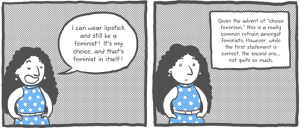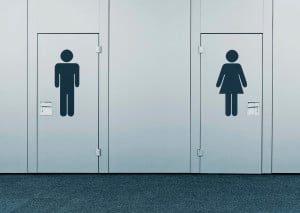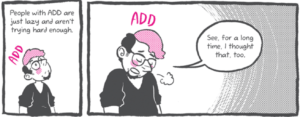
EF
Originally published on The Bilerico Project and cross-posted here with their permission.
Okay, so you get that gender identity is different from gender expression, which is different from sexual orientation.
You know the difference between transsexual, transgender, gender queer, gender fluid, and agender. You know that not everyone wants “the surgery,” and not to ask if they do.
You proudly claim the mantle of transgender ally. But are you one?
Some recent conversations I’ve had have revealed prevalent myths and misconceptions about transgender people that we need to move beyond. Simple definitions aren’t enough: we need to be talking about lived realities.
So here’s your Trans 201 lesson on 10 common misconceptions.
Myth 1) Getting a job as a trans person is just like getting a job as a gay person.
No. Virtually every transgender person is outed during the vetting process.
Whether it is because the person is not “passable” in some way, or because the background check reveals their previous name, or there is a DD214 (military discharge) they can’t update, or a Google search – if you’re transgender, chances are you will be outed eventually during the process, and it will likely (negatively) affect whether or not you are interviewed, much less extended a job offer.
One of my closest friends also works in government as a high-level technical person. We transitioned at the same time, and both of us are pretty visible as transgender people in industry. Before we transitioned, getting interviews – and doing very well in them – was easy.
Before I transitioned, I never interviewed for a job I didn’t get. My friend bounced from job to job, moving up the ladder, while pursuing whatever career seemed most interesting at the moment because getting interviews and offers was always so easy for her.
Since we have transitioned, the job-seeking process has become much harder. I have put out dozens of resumes for jobs I am qualified for, gotten one interview, and no offers. That one interview only happened because they still thought I was my “old name.” My friend has had similar experiences.
In short, if you’re transgender, finding a job is far, far harder than it is for others.
Myth 2) Dating for transgender people is just like LGB dating.
Dating for transgender people is a unique experience.
For starters, there is question of what to tell about your history, and when. This can be extremely dangerous, and frequently goes very poorly. Violence is often a result.
Even when there isn’t violence, it can still be humiliating. A friend recently told me the story of her date responding loudly with, “Oh, just what I fucking needed!” when she told him she is transgender. He then stormed out of the restaurant and stuck her with the bill for both their dinners.
Another issue is that transgender women frequently don’t fit inside of traditional notions of beauty. Men who do find us attractive are often acting on a fetish rather than interest in us as individuals.
Transgender women who are attracted to women often have an even more difficult time finding romantic partners than those attracted to men.
As such, many times only a transgender person can love another transgender person. However, in the hinterlands of America – where there often isn’t another one of us for an hour in any direction – this isn’t an option.
This is part of what I was referring to when I quoted Laverne Cox in saying, “Loving a transgender person is a revolutionary act.”
Myth 3) “Don’t pay attention to what others say.” “Just love yourself.” “Words only have power if you give them power.”
If all of this was true, then anti-bullying programs would be so easy! Just give kids a quick lesson in pop-psychology buzz phrases and boom! Bully-proof kids.
Except the human mind doesn’t work that way. And this is wrong from a moral perspective as well.
People can’t maintain a positive sense of self when there is literally nothing in their day-to-day life that they can touch/see/hear/feel that affirms their identity.
For a transgender kid in Nowhere, USA who is being treated like an abomination every day by virtually everyone, it does them next to zero good hearing that someone they will never meet who lives in a place they have never been “supports” them, in a non-specific “I’ve-never-met-you-and-never-will-but-I-value-people-like-you” sort of way.
Support and love needs to be tangible to resist tangible hate.
Beyond this, telling the victims that it is their fault if they can’t fight off the omnipresent messages of hate and loathing is victim-blaming.
Telling people “Words only have power if you give them power” is blame-shifting in the same way programs that teach women to avoid getting raped do.
They both move the burden of guilt to the innocent. It implies that it’s your own fault if you are victimized or suffer emotionally.
Myth 4) Geography doesn’t matter.
Living as a transgender person in London is different from California is a different from Ohio is different from the Deep South. You go from being a person in a protected class with full government recognition at all levels (and access to transgender specific health care) at one end, to a person who has human rights in name only on the other.
It’s the difference between full legal equality, and living as member of an untouchable caste.
This was never more evident than at the Transgender Leadership Summit two weeks ago, when people who mostly live in the Los Angeles, California area were stunned and appalled by stories being told by visitors from out of state.
Just because transgender people in your area seem to be doing okay, doesn’t mean it’s true for those of us elsewhere.
Myth 5) Career field doesn’t matter.
Transgender people working in career fields that are traditionally LGB-friendly have a far different experience than those working in industries that are not friendly to women or the LGB community.
In those industries, if you want to keep your job, you try to blend in – especially when finding a new job can be next to impossible.
For many transgender professionals, including myself and some of my closest friends, being transgender is that elephant in the break room that no one acknowledges. It may be an open secret in the office, but the fact that I have pictures of my partner and children in my cubicle is already considered “edgy.”
Myth 6) Everyone knows the difference between drag and transgender.
No. The religious right capitalizes on the conflation of drag and transgender all the time and uses it to claim that transgender people will show up to the office dressed like it’s Saturday night at The Masque.
If people didn’t conflate the two, the religious right wouldn’t be nearly so successful at fighting against workplace and employment protections for transgender individuals.
Additionally, it is patronizing when non-transgender people ignore transgender people who tell them stories about how they have seen the two conflated.
The difference between drag and transgender is pretty obvious to people who have been around either (or both) communities for any length of time.
However, given that only approximately 9% of Americans know someone who is transgender, this nuance escapes most people. This is especially true in areas where transgender people are widely scattered and often trying and blend into the woodwork (like, say, rural Ohio).
Myth 7) Race doesn’t matter in these discussions.
This is absolutely a myth. Most of the LGBT people murdered in hate crimes are transgender women. Of those transgender women, the vast majority were persons of color.
When you have any conversation about the transgender community, you have to include transgender women of color.
They are dying at a rate that’s approximately 3.7 times higher than the rest of the transgender community. They’re dying at a rate about 22 times higher than gay men in hate crimes.
Transgender women of color need veto power. They are the ones that will bear the consequences of whatever decisions are made.
Myth 8) “No, stop. You’re hurting me,” means “Keep doing what you’re doing.”
When a non-transgender person is doing something that many transgender women find painful and offensive, there is a particularly rape-y vibe to being told, “Hush, they’re just doing their thing.”
If you’re really a friend to the transgender community – and a lot of us are telling you that you’re damaging us with your actions – you should listen (and probably modify your behavior), regardless of the circumstances.
You may have good intentions, but there’s a saying about that sort of thing…
Myth 9) “Transgender” has clear definitions.
There is considerable debate over who fits under the umbrella term “transgender.” Some people reject the label; some accept it.
Ultimately, it is a matter of self-identification: if someone identifies as transgender, that’s their identity and you should respect it.
If someone doesn’t, respect that as well, and don’t put a label on them that they don’t want.
Myth 10) One voice can speak for all of us.
The lived experiences of transgender people are as diverse as the American experience itself. No one voice can speak for the entirety of the community. The amount of intersectionality is staggering, and can’t be ignored.
We all speak from our own lived experiences, our own truths. Denying them is a rejection of our identities that we have worked so hard to claim.
[do_widget id=”text-101″]
Brynn Tannehill is originally from Phoenix, Ariz. She graduated from the Naval Academy with a B.S. in computer science in 1997. She earned her Naval Aviator wings in 1999 and flew SH-60B helicopters and P-3C maritime patrol aircraft during three deployments between 2000 and 2004. She served as a campaign analyst while deployed overseas to 5th Fleet Headquarters in Bahrain from 2005 to 2006. In 2008 Brynn earned a M.S. in Operations Research from the Air Force Institute of Technology and transferred from active duty to the Naval Reserves. In 2008 Brynn began working as a senior defense research scientist in private industry. She left the drilling reserves and began transition in 2010. Since then she has written for OutServe magazine, The New Civil Rights Movement, and Queer Mental Health as a blogger and featured columnist. Brynn and her wife Janis currently live in Xenia, Ohio, with their three children. Follow her on Twitter @BrynnTannehill.
Search our 3000+ articles!
Read our articles about:
Our online racial justice training
Used by hundreds of universities, non-profits, and businesses.
Click to learn more




















